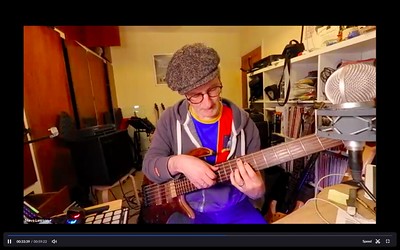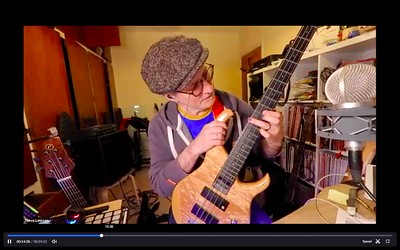I first taught one-on-one lessons online in the late 2000s. Skype wasn’t really up to the task, but a handful of people were interested in getting some lessons for whom me being thousands of miles away made in person lessons impossible.
[jump straight to bass lesson info]
I still did mainly in person lessons through most of the 2010s, gaining more online students as the decade went on.
 Heading into the COVID lockdown and everything moved online. I wrote tutorials for other teachers and performers in how to set up for streaming lessons and gigs, and got on with moving all my bass teaching online.
Heading into the COVID lockdown and everything moved online. I wrote tutorials for other teachers and performers in how to set up for streaming lessons and gigs, and got on with moving all my bass teaching online.
Recently a few people in the UK have asked about in person lessons, and were surprised when I said I only teach online these days. So I thought I’d better explain why.
The main reason is that my entire approach to teaching has adapted to suit being video’d, so that every lesson is viewable by the student as many times as they want after. It’s odd given how many video’d lessons by tuition sites actually end up following many of the conventions of in person masterclasses, but what video allows me to do is demonstrate an idea enough so that the student can rewatch the demo, rather than playing it enough to be able to remember it clearly until the next time they pick up a bass. This allows me to fit many, many times more material into a single lesson. Which in turn allows students to pick and choose what to work on.
 I am adamant that it is not my job to decide the exact path every student should go on. My students are almost exclusively grown-ass adults with a lifetime’s experience as music listeners, and generally some familiarity with the instrument (I love teaching total beginners, but it doesn’t happen very often). My task is to equip them to play the music that inspires and motivates them, to plot a journey towards their own creative aspirations and intentions. For some of them that’s playing bass in a band in a particular genre. For others it’s about broadening their general skill set regarding navigating the fretboard in terms of keys and melodic/intervallic patterns. For some it’s developing a practice towards building a vocabulary for improvisation, and still others it’s playing solo. I don’t decide what they should want to do, I just give them the tools to get there. And in any given week, I give them WAY more tools than they need, because I can, and because while rewatching the video there might be one section that really connects with them that they can watch over and over again and really dig into. They also have a document of their own playing that can be really useful for reflective and reflexive assessment of where they are up to.
I am adamant that it is not my job to decide the exact path every student should go on. My students are almost exclusively grown-ass adults with a lifetime’s experience as music listeners, and generally some familiarity with the instrument (I love teaching total beginners, but it doesn’t happen very often). My task is to equip them to play the music that inspires and motivates them, to plot a journey towards their own creative aspirations and intentions. For some of them that’s playing bass in a band in a particular genre. For others it’s about broadening their general skill set regarding navigating the fretboard in terms of keys and melodic/intervallic patterns. For some it’s developing a practice towards building a vocabulary for improvisation, and still others it’s playing solo. I don’t decide what they should want to do, I just give them the tools to get there. And in any given week, I give them WAY more tools than they need, because I can, and because while rewatching the video there might be one section that really connects with them that they can watch over and over again and really dig into. They also have a document of their own playing that can be really useful for reflective and reflexive assessment of where they are up to.
Every lesson begins with me asking ‘what have you been playing this week?’ The answer to that doesn’t have to be related to the previous week, but more often than not it’ll be the development of something we were looking at in that lesson. Video really helps people diagnose their own weaknesses and areas for development, so I find students are way, way better at going ‘ah, I was really struggling with that aspect, so I spent a week on that’ – and ‘that aspect’ might not have actually been the topic of the previous lesson, just some technical or theoretical hurdle that needed to be surmounted to get there.
I’m finding that students progress faster on Zoom. A LOT faster. Their practice through the week is way more focused with the recall the video allows, and their path is way more refined towards their evolving creative goals.
So if that sounds good, drop me a line and we’ll get something booked in. All the deets are Here on the teaching page.
